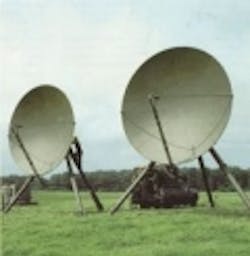Army orders long-range secure microwave troposcatter communications system from General Dynamics SATCOM
FORT MONMOUTH, N.J., 26 Dec. 2010.Military communications specialists at the General Dynamics SATCOM Technologies segment in San Jose, Calif., will provide the U.S. Army with a special long-range secure microwave communications system under terms of an $8.3 million contract awarded Thursday from the Army Communications-Electronics Command (CECOM) contracting center at Fort Monmouth, N.J.
General Dynamics SATCOM will provide the Army with one Troposcatter System, as well a related test equipment, spare parts, training, and support. Troposcatter communications -- short for tropospheric scatter -- transmits and receives microwave signals at distances as far as 200 miles, which is considerably farther than traditional line-of-sight microwave communications.
This communications mode scatters radio waves as they pass through upper layers of Earth's lowest layer of atmosphere, called the troposphere, where most of the planet's water vapor resides. Troposcatter communications transmit radio signals in tight beams aimed at the tropopause located midway between the transmitter and receiver sites. The tropopause is the boundary between the troposphere and the stratosphere.
While traditional line-of-sight microwave communications use frequencies between 12 and 19 GHz, troposcatter communications use frequencies around 2 GHz. Only a small portion of troposcatter radio waves can be received, so large high-gain dish antennas are necessary.
Troposcatter communications typically are secure because their radio waves are difficult for enemies to intercept, hence their interest for military communications. General Dynamics will do the work on this contract in San Jose, Calif., and should be finished by January 2012.
For more information contact General Dynamics SATCOM online at www.gdsatcom.com, or CECOM at http://cecom.army.mil.
